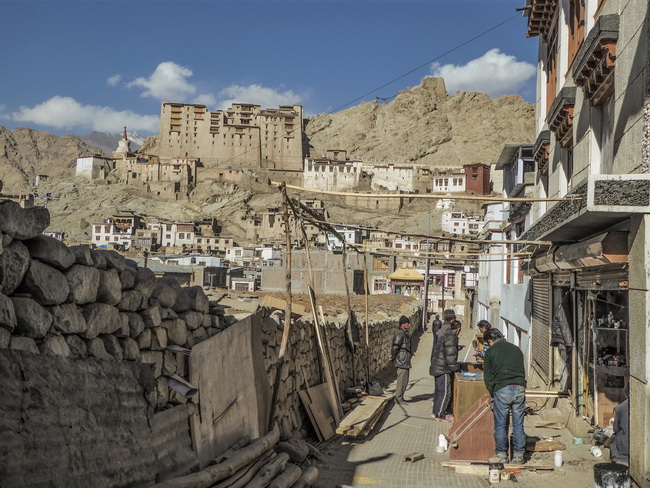There are a few organisations in Ladakh that are working tirelessly to preserve these centuries-old traditions and heritage and conserve the fragile environment of this cold desert Himalayan town.
Ladakh is famous for its natural beauty, pristine landscape, snow-capped mountains and glaciers, rugged trekking trails, wildlife, and medicinal plants. However, what attracts tourists the most to Ladakh is its values, culture and centuries-old heritage and traditions. Even though Ladakh is going through a major transformation, and witnessing rapid economic and social changes owing to the increase in the footfall of tourists over the last few decades, there are a few organisations in Ladakh that are working tirelessly to preserve these centuries-old traditions and heritage and conserve the fragile environment of this cold desert Himalayan town.
Here are a few organisations that are actively working for the preservation and conservation of Ladakhi culture, heritage and environment.
Ladakh Ecological Development Group (LEDeG)
LEDeG, established in 1983 by a Swedish linguist called Helena Norberg-Hodge, is one of the oldest non-government organisation (NGO) in Ladakh. LEDeG, which has its office near Karzoo Zing, aims to promote ecological and sustainable development of Ladakh, with its focus on the promotion of renewable energy, particularly solar energy. LEDeG has installed micro-hydel and solar power in remote villages, pioneered in the field of food processing and agriculture, propagated cost-effective and environment-friendly building technologies by producing building materials such as hollow concrete and stabilised mud blocks. LEDeG is also working with self-help groups, where it provides marketing support to the artisans, and train women from remote areas on new designs, techniques and adoption of new technologies. LEDeG also has a handicraft shop where they sell products of these SGHs.
Ladakh Arts and Media Organisation (LAMO)
Ladakh Arts and Media Organisation (LAMO), established in 1996, has been working to articulate an alternative vision for the arts and media in Ladakh. LAMO is housed in two 17th-century houses- Munshi house that belonged to King’s secretary, and the Gyaoo House, which was home to the court artists. Both these houses have been restored and converted into an office space with galleries and library. LAMO organises screening of films, and workshops and exhibitions about Ladakh’s culture, performing arts and literature.
LAMO won the 2018 UNESCO Asia-Pacific Award for Cultural Heritage conservation for the restoration of an aristocratic house project from partial ruin state.
Leh Old Town Initiative (LOTI)
The old town of Leh called Kharyog (below palace) is one of the most important places in Leh district as it has around 200 buildings, including residential houses, Buddhist monasteries and mosques below the 17th century Leh Palace. The old town is also testimony Ladakh’s centuries-old social relationship with Central Asia, Tibet and Kashmir. However, due to rapid urbanisation and people preferring concrete cemented buildings instead of traditional mud houses, many old buildings were demolished. It was due to the timely intervention of Tibet Heritage Fund (THF) by registering Leh Old Town Initiative (LOTI) in 2005 as a local NGO to preserve these historical houses by restoring them and creating an alternative approach so that the owners and also the government think of another approach rather than replacing these historic buildings with concrete buildings. The Leh Old Town Project was one of the winning entries in the 2006 UNESCO Asia-Pacific Heritage Awards.

Himalayan Institute of Alternatives, Ladakh (HIAL)
HIAL or Himalayan Institute of Alternatives, Ladakh was established in 2017 by Sonam Wangchuk, a mechanical engineer by profession who also started SECMOL (Students Educational and Cultural Movement of Ladakh). HIAL has its campus at Phyang where students learn by doing, through collaborative teaching and research and innovation. Unlike other institutes, HIAL believes in providing real-life lessons to the students. Their certificate course includes organic farm and forest produce processing, responsible tourism and eco-responsive buildings.
Women’s Alliance of Ladakh
Women’s Alliance of Ladakh, or Ama Tsogspa, was also founded by Helena Norberg-Hodge in 1991. As the name suggests, this organisation was formed to raise the status of rural women and to strengthen the local culture and agriculture. The organisation that is working on reinstating the decision-making power of the women has more than 5,000 members from almost 100 villages from all parts of Ladakh.
Women’s Alliance opened a craft shop in 2001 intending to sell local products and thereby helping to boost the local economy and also preserve traditional skills. The organisation also organises WAL Annual Festival, where all the members from Ladakh assemble to raise awareness about the preservation of traditional skills and practices. Tourists can savour traditional Ladakhi food such as tapu, paba and tangtur, and momos, and relish local drinks such as seabuckthorn and apricot juice, etc. Women’s Alliance also screens two documentary movies based on Helena’s books- Ancient futures and The economics of happiness.
All these organizations can be found on this map of Leh-Ladakh. They are constantly looking for sponsors and volunteers; more details is available on their websites.






































































































































































